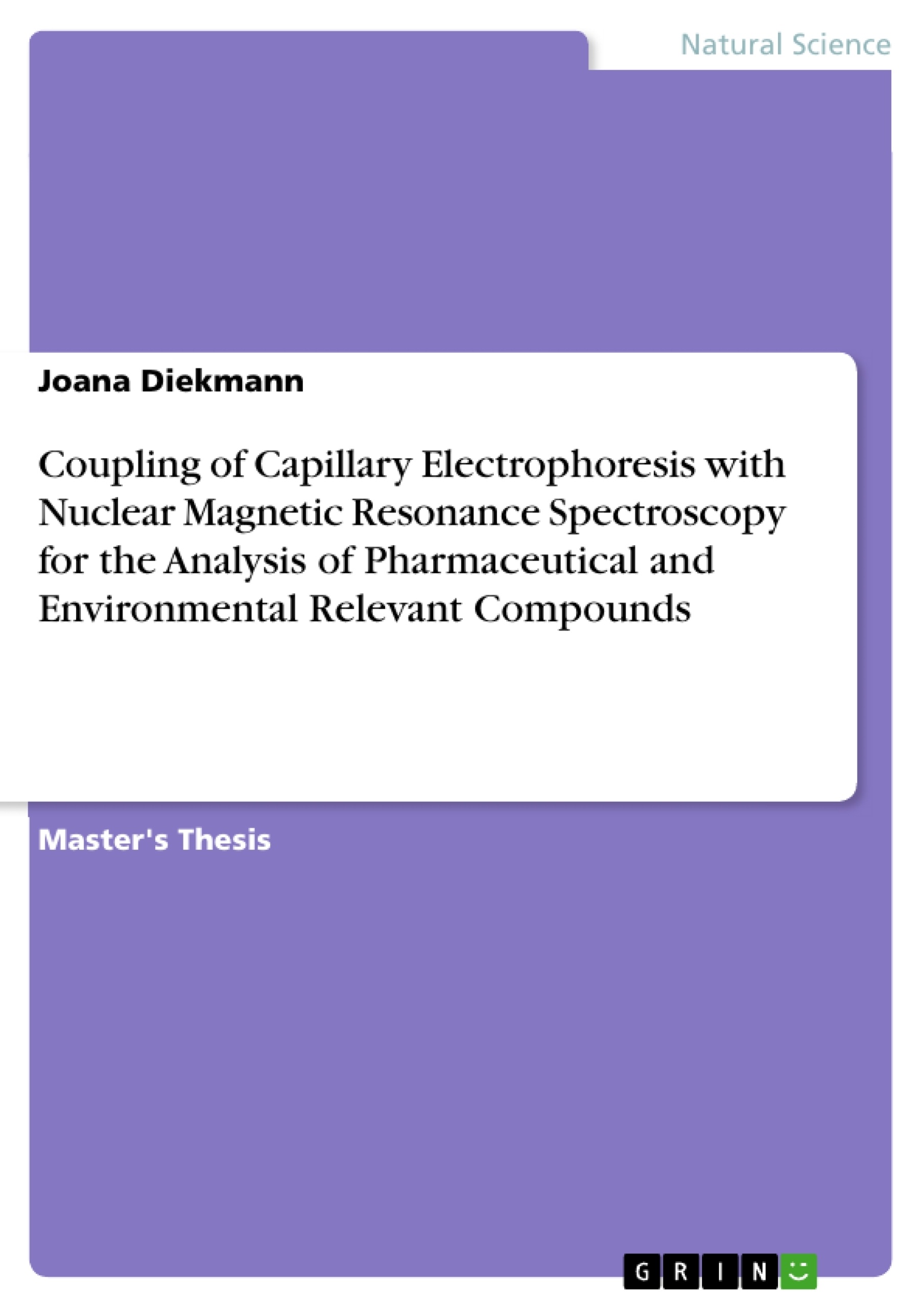Separation and identification of mass-limited chemical samples is the key to understand the complex nature of pharmaceutical and environmental systems. High efficiency separation techniques, such as capillary electrophoresis (CE), coupled to a non-destructive, information-rich detection, such as nuclear magnetic resonance (NMR) spectroscopy, have revolutionized the ability to separate and identify components in small sample volumes. Using this hyphenated system, structure elucidation of analytes separated during an electrophoretic process can be performed using NMR as an on-line detector. Although sensitivity remains an issue for on-line NMR detection, capillary NMR spectroscopy using microcoils has emerged as a major breakthrough for increasing the mass-sensitivity of NMR spectroscopy, because the limit of detection is proportional to the coil diameter. A further development is the miniaturization of the magnet enabling the possibility of a truly portable NMR system. This portable, low-cost NMR sensor, coupled to the rapid CE separation system could enable high-throughput and on-site identification of nanoliter amounts of solution. Furthermore, CE can provide on-line pre-concentration via electrokinetic injection or other stacking techniques to increase the sample concentration.
In this research, coupling CE to a laboratory-scale NMR and to a portable NMR system are investigated, with the emphasis on the development of the miniaturized system. For the experiments with the large-scale 1H NMR system, a group of selected uric acids and xan- thines are studied since those compounds are representative of various classes of therapeutical drugs. The portable NMR instrument incorporates lithographically patterned microcoils and a small 1.8 T permanent magnet to measure 19F NMR spectra for the analysis of trifluoroacetic acid (TFA) and longer chain perfluorinated carboxylic acids (PFCAs). Our results demonstrate that coupling CE to a portable NMR system is feasible and can provide a low cost method to obtain structural information about the samples of interest. The results confirm that it was possible to acquire congruent sample data using the ultraviolet/visible (UV/VIS) detector of the CE and the 19F NMR detector. To obtain data, CE and NMR conditions were optimized and different modes of data acquisition were investigated.
Inhaltsverzeichnis (Table of Contents)
- Abstract
- Zusammenfassung
- Acknowledgement
- Introduction
- Theoretical Background
- Capillary Electrophoresis (CE)
- Nuclear Magnetic Resonance (NMR) Spectroscopy
- Principles of NMR Spectroscopy
- NMR Detection Techniques
- Microcoil NMR
- Coupling CE to NMR Spectroscopy
- On-Line CE-NMR
- Experimental Section
- Chemicals and Materials
- Instrumentation and Methods
- Large-Scale 'H NMR System
- Portable 'F NMR System
- CE-NMR System
- Sample Preparation
- Results and Discussion
- Large-Scale 'H NMR Experiments
- Portable 'F NMR Experiments
- CE-NMR Experiments
- Data Analysis and Evaluation
- Conclusions
Zielsetzung und Themenschwerpunkte (Objectives and Key Themes)
This Master thesis explores the potential of coupling capillary electrophoresis (CE) with nuclear magnetic resonance (NMR) spectroscopy for the analysis of pharmaceutical and environmental relevant compounds. The main objective is to investigate the feasibility and advantages of using a portable NMR system coupled to CE for on-site and high-throughput identification of analytes in small sample volumes.
- Integration of CE and NMR for efficient analyte separation and identification
- Exploration of portable NMR systems for on-site analysis
- Development of methods for analyzing pharmaceutical and environmental compounds
- Enhancement of sensitivity and throughput in analytical techniques
- Optimization of experimental parameters for CE-NMR coupling
Zusammenfassung der Kapitel (Chapter Summaries)
- The Introduction provides an overview of the research topic and the significance of coupling CE to NMR spectroscopy for analyzing pharmaceutical and environmental samples. It highlights the importance of miniaturization and portability in NMR technology for on-site analysis.
- The Theoretical Background section delves into the fundamental principles of CE and NMR spectroscopy, including the various detection techniques used in NMR. It also explores the advantages of microcoil NMR for increasing sensitivity and the concept of on-line CE-NMR coupling.
- The Experimental Section details the chemicals, materials, and instrumentation used in the research. It describes the large-scale 'H NMR system, the portable 'F NMR system, and the CE-NMR system employed in the experiments. Sample preparation procedures are also outlined.
- The Results and Discussion chapter presents the findings of the experiments, focusing on the results obtained with the large-scale 'H NMR system, the portable 'F NMR system, and the CE-NMR system. The analysis and evaluation of the data are discussed, highlighting the advantages and limitations of the various techniques.
Schlüsselwörter (Keywords)
This research focuses on the coupling of capillary electrophoresis (CE) with nuclear magnetic resonance (NMR) spectroscopy, particularly with portable 'F NMR systems, for the analysis of pharmaceutical and environmental compounds. Key topics include microcoil NMR, on-line CE-NMR, perfluorinated carboxylic acids, trifluoroacetic acid, xanthine, and uric acids. The study aims to demonstrate the feasibility and advantages of this hyphenated analytical technique for high-throughput, on-site analysis of small sample volumes.
- Quote paper
- Joana Diekmann (Author), 2009, Coupling of Capillary Electrophoresis with Nuclear Magnetic Resonance Spectroscopy for the Analysis of Pharmaceutical and Environmental Relevant Compounds, Munich, GRIN Verlag, https://www.grin.com/document/169088



